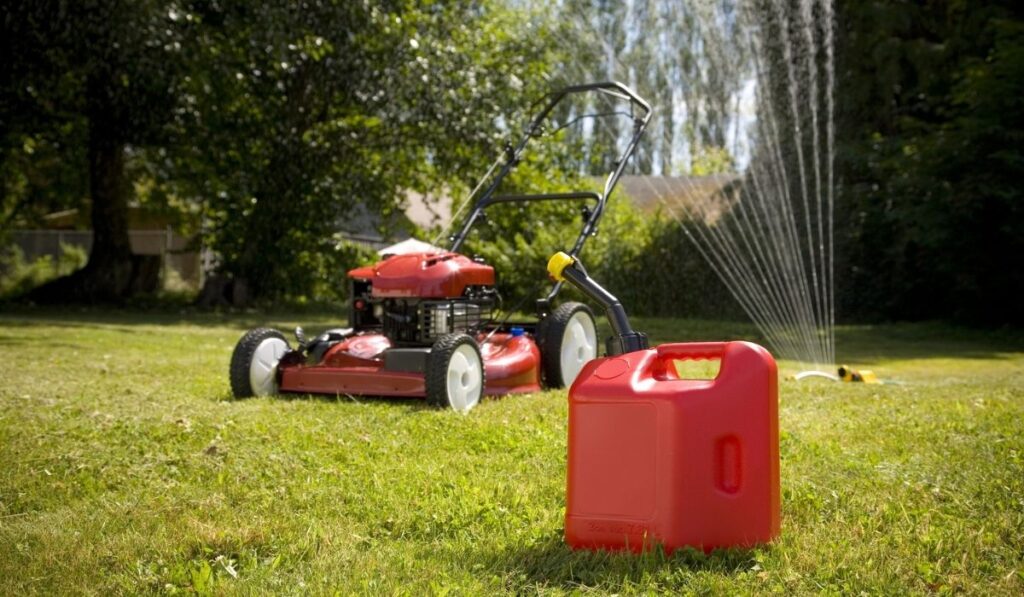Once the mowing season ends, your lawnmower is probably going to sit in the garage for a few months. And if you’re like most people, you may not be too eager to drain the gas tank before you put it away. But should you leave the gas in there and not worry about it? Is that a safe option?
If you’re storing your lawnmower for less than a month, there’s no problem leaving gas in the tank. But over longer periods, the gas will degrade and may cause all sorts of problems, from engine knocking to gummed-up fuel lines and carburetors. It may also lead to rusting.
If you’re not going to use your lawnmower for a while, it’s best to drain the gas and store the mower with an empty tank. This will help keep the engine components clean and free of corrosion. Let’s take a look at some of the easiest ways to drain your gas tank so that you can keep your lawnmower in good condition for the next season.
Is It Safe to Store a Lawn Mower With Gas in it?

The simple answer is no; it is not safe to store a lawnmower with gas in it, at least not for a while. Gas or gasoline is a volatile organic substance that degrades over time.
This means that the volatile part will eventually evaporate, and you will be left with a sticky, gummy substance that can clog up the fuel lines and carburetor of your lawnmower.
It also increases the risk of tank corrosion because the remaining air in the tank may condense into the water. Furthermore, the mixture of gas and water is a perfect recipe for rust.
How Do I Properly Drain Gas From My Lawn Mower?
There are a few different ways to drain gas from your lawnmower. Just make sure you follow the safety precautions since capsizing your lawnmower to drain fuel is a terrible idea. Improper methods can cause engine damage or even start a fire.
Use a Siphon
A siphon is probably the best tool to drain a gas tank. It is a tool with a long tube and a small suction pump in the center. To use a siphon, put one end of the line in the gas tank and the other in a container to collect the gas.
Make sure the container is lower than the gas tank so the gas will flow freely. Once everything is set up, pump the siphon a few times to create a vacuum and draw the gas out of the tank. After the initial flow starts, stop pumping, and the fuel will start flowing under gravity.
Siphon kits can be bought at most hardware stores; make sure you get the one according to the size of your lawnmower’s gas tank. We recommend the KATUMO Siphon Hose (on Amazon).
Use a Makeshift Hand Pump
If you don’t have a siphon, don’t worry; there are always alternatives. One way is to make a makeshift hand siphon. You’ll need two transparent tubes, one longer than the other, and a bucket.
Place one end of both tubes in the tank, making sure they’re submerged but not touching the bottom, and then cover the tank with the lid. Use rags to seal the opening completely. Like the siphon, make sure the bucket is lower than the tank.
Now, put the other end of the longer tube in the bucket while the other end of the shorter tube is in your mouth. And blow! It’ll increase pressure in the tank, forcing the gas into the longer tube to the container. Stop blowing once the flow starts; it’ll begin to drain under gravity.
Drain Through the Fuel Line
You have the easiest option if your lawnmower has a separate fuel line running between the fuel tank and carburetor. All you have to do is disconnect the line and drain the fuel into a container.
Use a Turkey Baster
It might not be the most elegant option, but it does the job. Just squeeze the bulb and insert the baster into the gas tank. Next, release the bulb to suck the fuel into the baster. When it’s full, remove the baster from the tank and release the fuel into a suitable container.
Whatever method you use, make sure you do it outdoors, away from ignition sources. Once the gas is drained, use a couple of rags to clean up any remaining gas.
Next, slosh some fresh fuel in the tank, and again clean with rags. Then, start the mower and let it run until it’s out of fuel. This will help clean out the lines and carburetor.
How Long Can Gas Stay in the Lawn Mower?

The volatile part of ethanol starts evaporating as soon as it’s exposed to air, and this process speeds up when the temperature is higher.
So gasoline usually starts to degrade after 30 days in the fuel tank and even less if it’s been stored in a warm environment. Ethanol-free gas has a longer shelf life, but it’s expensive, and nobody fills their lawnmower with it.
Fuel-stabilizers, such as the STA-BIL Storage Fuel Stabilizer (on Amazon), may help extend the life of gas for some additional months, but they’re not 100% effective. So even with a stabilizer, it’s a good idea to drain the gas if you don’t intend to use the lawnmower for a while.
How Can I Tell If My Lawn Mower Has Bad Gas in it?
If you suspect that your lawnmower is running on bad gas, we have a few tips to help you diagnose the problem.
Lawnmowers with bad gas don’t start easily, and even if they do, they stall often. The engine may also sputter or stall.
To confirm that the problem is with the gas, try smelling it. Although most people might not like it, bad gas does have a characteristic smell. If it has a strong, pungent varnish-like odor, it’s definitely gone bad.
Another way to check is to look at the fuel. Drain a small amount of gas into a clear container, and if it’s dark and has a sludgy appearance, that’s a sign that the ethanol has evaporated and the fuel has gone bad.
